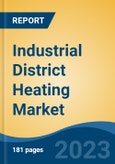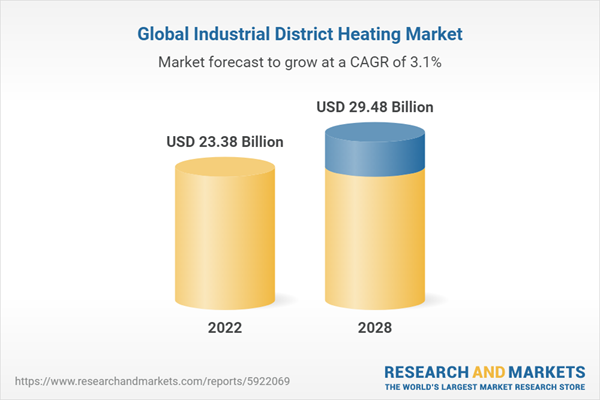Speak directly to the analyst to clarify any post sales queries you may have.
10% Free customizationThis report comes with 10% free customization, enabling you to add data that meets your specific business needs.
Key Market Drivers
Rising Need to Diminish the Carbon Emission will Augment Growth in the Market
Population across the globe has risen at an exponential rate in recent years, which led to increased urbanization being witnessed across different regions. This has directly increased the demand for energy from various end-use sectors. Industrial District Heating is capable of producing a large amount of energy at a central plant, and further transmitting it to different end-use industries acts as an effective solution for sufficing the heat demand.The world is struggling with threats due to unprecedented carbon emissions and global warming, resulting in an increased inclination toward renewable energy resources. The U.K. has proclaimed an incentive package of USD 2 billion investment for the heating sector from 2015-to 2025. Germany has announced an investment of around 1 billion by 2030. Similar packages are expected in Denmark, Netherlands, and China in the coming years. Poland has broadcasted an investment of USD 5 billion from 2018 to 2028 in the heating sector.Flexibility in the Source of Heat Generation and Cost-effectiveness to Propel Growth
Industrial District Heating provides the choice of heat generation using numerous sources such as coal, renewables, gas, oil & crude product, and alternative accessible sources. Recent trends witnessed renewables and gas to be progressively employed in Industrial District Heating systems as these resources directly facilitate reducing gas emissions and serve in achieving energy targets. These operational advantages will drive the Industrial District Heating market growth in the coming years.Download free Sample Report
Key Market Challenges
High Initial Capital Investment for Infrastructure May Restrict Market Growth
The setting up of a Industrial District Heating capacity requires an initial hefty capital investment as installing a safe transmission and distribution lines network is very costly. The insulated pipes and their underground laying require a considerable investment, which is a major obstacle for investors. Also, lack of required infrastructure and availability of other economical options for space heating and water heating may hamper the growth of the market in the coming years.Key Market Trends
High Initial Capital Investment for Infrastructure May Restrict Market Growth
Industrial District Heating systems promote the deployment of renewable biomass, municipal waste, industrial waste, and waste from CHP for energy production using those sources. This, in the long run, will drive the market growth rate as the demand for renewables increases with a growing emphasis on bringing down the carbon footprint. Currently, Europe leads the Industrial District Heating industry, owing to extensive installation being carried out in the region. Other countries in the region also have planned installations in the coming years that will cater to the market growth. The population throughout the world has grown at a sudden rate in recent years, which has led to augmented urbanization being perceived across various regions. This has unswervingly amplified the demand for energy from numerous end-use sectors. Industrial District Heating is able to produce a huge amount of energy at a central plant, and further transmitting it to diverse end-use industries acts as an efficient solution for serving the heat demand. Industrial District Heating systems are known for their energy efficiency as they centralize heat production, enabling the utilization of waste heat from industrial processes or power generation, which would otherwise be wasted.The increasing urban population leads to higher demand for heating solutions, and Industrial District Heating offers an efficient way to provide heat to densely populated areas.
Industrial District Heating facilitates the integration of renewable energy sources such as solar, geothermal, and biomass, helping to diversify the energy mix. During the COVID-19 pandemic, numerous nations imposed a country-wide lockdown to avert the further spread of this fatal virus, which has disrupted numerous activities involving construction, novel infrastructure development, installation of turbines, and others. This led to the government organizations and personal companies being worried about the construction of heating networks postponing numerous Industrial District Heating (DC) projects. This is due to the unapproachability of the workforce to finish the project in an exceptionally definite time along with disturbances in supply chains on account of travel bans throughout various states and nations.
Segmental Insights
Heat Source Insights
The renewables segment is projected to dominate the market in the coming years. Power utilities are upgrading to clean energy from fossil fuel to increase power generation capacity as the awareness concerning environmental safety is increasing among folks, and thus the government is imposing strict regulations for emissions and pollution. This will increase the installation of renewable sources for heat generation around the world. The benefits of the conception, such as higher potency and negligible carbon emissions, have driven the expansion of this section.The gas section is likely to expand considerably throughout the forecast period. Exploration activities are rising around the world, and gas plants are significantly efficient and have less harmful effects on the surroundings in contrast to fossil fuels. Gas is extravagantly accessible, and the installation of such plants is increasing globally.Plant Type Insights
Based on plant type, the market is segmented into boilers, Combined Heat and Power Plants (CHP), and others. CHP systems modify electricity generation alongside heat being created for the heating systems. This can be the most important considering the expansion of the CHP segment’s market share in recent years. The other factor contributing to the growth of this segment is the increasing electricity demand across the world. Further, CHP systems have higher efficiency as compared to normal boilers and diminish the prices as they avoid distribution and transmission losses. Also, support from governments in promoting the use of the CHP systems has power-assisted the expansion of the market.The boiler section is projected to witness growth throughout the forecast period as a result of increasing demand for electricity around the world. The installation of various energy plants is additionally increasing around the world.Download free Sample Report
Regional Insights
Europe has led the Industrial District Heating market share as the region has low-temperature circumstances for most of the year. Europe comprises large industries and power plants from which heat is created that goes to waste.North America is anticipated to grow considerably during the forecast period. The demand for heating and electricity is expanding in the region. The region even experiences low temperatures for a long time in a year, which raises the demand for heating water and residential, commercial, and industrial spaces.
Asia Pacific ranks as the most lucrative DC market. China is increasing its investments in heating networks. Europe has dominated the market as the region has low-temperature conditions for most of the year. Europe consists of large industries and power plants from which heat is generated that goes to waste. Such heat is utilized to meet all heating demands within the region. The installation of renewable sources of energy is also increasing, and the waste heat from such plants is widely used for heating purpose only due to extreme weather conditions. This drives the market growth in Europe during the forecast period.North America is projected to grow significantly during the forecast period. The demand for heating and electricity is increasing widely in the region. The region even faces low temperatures for a long time in a year, which increases the demand for heating water in residential, commercial, and industrial spaces. The U.S. holds a dominant Industrial District Heating market share in this region. Asia Pacific positions as the most lucrative market for district heating. China is increasing investments in heating networks. China, which experiences low temperatures, has witnessed maximum deployment of heating plants. The installation of renewable heating plants is also increasing in this region, and along with China, other countries, including South Korea, are also increasing their heating capacities.
Report Scope:
In this report, the Global Industrial District Heating Market has been segmented into the following categories, in addition to the industry trends which have also been detailed below:Global Industrial District Heating Market, By Heat Source:
- Coal
- Natural Gas
- Renewables
- Oil & Petroleum Products
- Others
Global Industrial District Heating Market, By Application:
- Residential
- Commercial
- Industrial
Global Industrial District Heating Market, By Plant Type:
- Boiler
- CHP
- Others
Global Industrial District Heating Market, By Region:
- North America
- United States
- Canada
- Mexico
- Asia-Pacific
- China
- India
- Japan
- South Korea
- Indonesia
- Europe
- Germany
- United Kingdom
- France
- Russia
- Spain
- South America
- Brazil
- Argentina
- Middle East & Africa
- Saudi Arabia
- South Africa
- Egypt
- UAE
- Israel
Competitive Landscape
Company Profiles: Detailed analysis of the major companies presents in the Global Industrial District Heating Market.Available Customizations:
Global Industrial District Heating Market report with the given market data, the publisher offers customizations according to a company's specific needs.This product will be delivered within 1-3 business days.
Table of Contents
Companies Mentioned
- Danfoss Group (Denmark)
- Ramboll (Denmark)
- Dall Energy (Denmark)
- Veolia (France)
- Helen (Finland)
- Alfa Level (Sweden)
- GE (U.S.)
Table Information
| Report Attribute | Details |
|---|---|
| No. of Pages | 181 |
| Published | November 2023 |
| Forecast Period | 2022 - 2028 |
| Estimated Market Value ( USD | $ 23.38 Billion |
| Forecasted Market Value ( USD | $ 29.48 Billion |
| Compound Annual Growth Rate | 3.1% |
| Regions Covered | Global |
| No. of Companies Mentioned | 7 |









